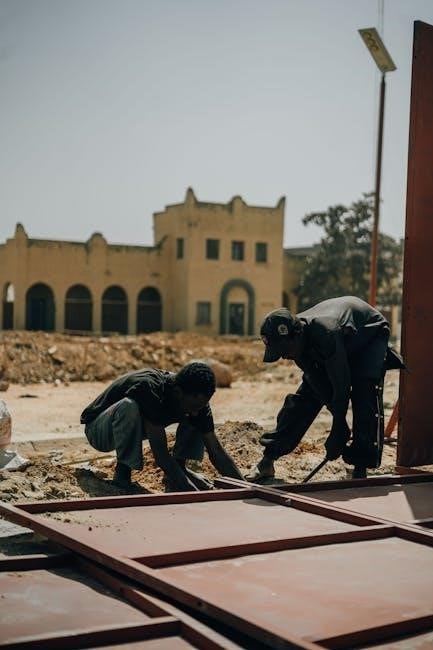HardiePanel 4×8 siding offers durability and aesthetic appeal, ideal for exterior walls. Proper installation ensures long-lasting performance and protection against the elements. This guide provides a comprehensive overview of the process, tools, and best practices for successful 4×8 Hardie Panel installation, ensuring a professional finish and adherence to manufacturer guidelines.
Overview of Hardie Panels and Their Benefits
Hardie Panels are durable, fiber-cement siding solutions designed for exterior walls. They offer superior resistance to weather, pests, and fire, making them a long-lasting choice. Available in various textures and sizes, including 4×8 panels, they provide versatility for different architectural styles. Their pre-primed finish simplifies painting, while optional ColorPlus technology offers a factory-applied finish. Hardie Panels are cost-effective, low-maintenance, and environmentally friendly, ensuring a high return on investment. They are ideal for both new constructions and renovations, delivering a modern, resilient exterior cladding solution that enhances curb appeal and protects against the elements.
Importance of Proper Installation Techniques
Proper installation of 4×8 Hardie Panels is crucial for ensuring durability, weather resistance, and a polished appearance. Improper techniques can lead to warping, water damage, or structural issues, voiding warranties. Correct alignment, spacing, and fastening are essential to prevent gaps and ensure panels withstand environmental stress. Following manufacturer guidelines guarantees optimal performance and longevity. Proper installation also enhances energy efficiency and maintains the aesthetic appeal of the siding. Adherence to safety protocols and building codes ensures a secure and professional finish, protecting the home from potential hazards like moisture intrusion or pest infestation. Attention to detail is key for a successful, long-lasting installation.
Tools and Materials Required for Installation
Essential tools include circular saws, drills, and utility knives for cutting and fastening. Materials like corrosion-resistant screws, weather-resistant barriers, and caulk ensure a secure and durable installation process.
Essential Tools for Cutting and Fastening Hardie Panels
The installation of 4×8 Hardie Panels requires specific tools to ensure precision and security. A circular saw or miter saw is ideal for cutting panels accurately, while a utility knife can be used for smaller adjustments. For fastening, corrosion-resistant screws or nails are recommended to prevent damage and ensure durability. Drills with appropriate drill bits are necessary for pre-drilling holes to avoid cracking. Additionally, a chalk line and level are essential for aligning panels properly. Safety gear, such as gloves and masks, should always be worn during cutting and handling to protect against silica dust.
Recommended Fasteners and Adhesives for Secure Installation
For a secure and durable installation, use corrosion-resistant screws or nails, ensuring they are positioned 3/8 inch from panel edges and no closer than 2 inches from corners. Avoid nailing into corners to prevent damage. Adhesives should be high-quality, paintable caulks meeting ASTM C-834 or C-920 standards, though ColorPlus finishes may require alternative solutions. Proper fastening and sealing ensure weather tightness and long-term performance, adhering to manufacturer guidelines for optimal results and warranty compliance.

Surface Preparation for 4×8 Hardie Panel Installation
Inspecting and cleaning the wall surface, ensuring proper alignment and framing are crucial steps for a successful 4×8 Hardie Panel installation. This ensures a secure fit and prevents future issues.
Inspecting and Cleaning the Wall Surface
Before installing 4×8 Hardie Panels, ensure the wall surface is clean, dry, and free of debris. Inspect for structural damage, cracks, or uneven areas that may affect installation. Address any issues to prevent future problems. Clean the surface thoroughly to remove dirt, oil, or old adhesives, ensuring proper adhesion. Check for mold or mildew and treat if necessary. Verify the wall is level and plumb, making adjustments as needed. A properly prepared surface ensures a secure and even installation, preventing gaps or misalignment. Follow manufacturer guidelines for surface preparation to guarantee optimal results.
Ensuring Proper Alignment and Framing
Proper alignment and framing are critical for a successful 4×8 Hardie Panel installation. Ensure the wall studs are spaced no more than 24 inches on center and are plumb. Check the framing for squareness and levelness to avoid panel misalignment. Use a chalk line to guide panel placement, maintaining straight lines. Ensure panels are installed plumb and level, with proper clearance from paths, steps, and driveways; Verify all fasteners are securely attached to framing members, avoiding nails in corners. Correct alignment prevents water intrusion and ensures structural integrity, guaranteeing a professional and durable finish.

Step-by-Step Installation Process
Begin with starter strips, align panels using chalk lines, secure with fasteners, leave gaps for caulking, and ensure plumb and level installation for a professional finish.
Starting with Starter Strips and Initial Panels
Begin by installing starter strips along the bottom edge of the wall, ensuring they are level and securely fastened. These strips provide a stable base for the first panel. Align the initial panel with the starter strip, using a chalk line to guide placement. Secure it with appropriate fasteners, spaced evenly to prevent warping. Ensure the panel is plumb and level before moving to the next one. Proper alignment and fastening at this stage set the foundation for a successful installation, maintaining structural integrity and visual appeal.
Cutting Panels to Size and Securing Them
Cut 4×8 Hardie panels using a circular saw or fiber-cement blade, ensuring precise measurements. Wear protective gear, including a dust mask, to handle silica dust safely. For curved cuts, use a jigsaw with a carbide-tipped blade. After cutting, smooth edges with sandpaper. Secure panels using corrosion-resistant screws or nails, spaced 3/8 inch from edges and no closer than 2 inches from corners. Avoid nailing into corners to prevent cracking. Fasteners should penetrate studs by at least 1 inch for a secure hold. Apply a high-quality caulk to all joints for weatherproofing, ensuring a durable and visually seamless installation.
Handling and Storage of Hardie Panels
Store 4×8 Hardie panels flat, keeping them dry and protected from standing water. Limit stacking to 4 pallets high. Handle carefully to avoid flexing or cracking.
Best Practices for Storing Panels Before Installation
Store 4×8 Hardie panels flat on pallets to prevent warping or cracking. Keep them dry and protected from standing water. Use a clean, stable surface and ensure panels are securely bundled. Avoid stacking more than 4 pallets high to prevent damage. Store in a well-ventilated area, away from direct sunlight and moisture. Handle panels carefully, lifting from the sides to maintain structural integrity. Clean panels before storage to remove dirt or debris, ensuring proper adhesion during installation. Follow manufacturer guidelines for storage to maintain product warranty and quality.
Preventing Damage During Transportation and Handling
Transport 4×8 Hardie panels on flat, stable surfaces to avoid bending or cracking. Secure panels tightly to prevent shifting during transit. Use dollies or forklifts with soft padding to lift and move panels, minimizing direct contact. Handle panels by the edges, never by the face, to avoid fingerprints and damage. Inspect panels for defects before transporting and installation. Avoid dragging panels, as this can cause scratches or breaks. Store panels upright if space is limited, ensuring they remain dry and secure. Always follow manufacturer guidelines for handling to maintain product integrity and warranty.
Safety Protocols for Installers
Wear protective gear, including gloves, safety glasses, and a respirator when cutting or handling Hardie panels. Use proper tools and follow manufacturer guidelines to minimize risks and ensure a safe working environment.
Protective Gear and Safety Precautions
Installers must wear protective gear, including gloves, safety glasses, and a dust respirator, to safeguard against silica dust and debris. Ensure proper ventilation when cutting panels to minimize dust exposure. Use HEPA vacuums or wet cleanup methods to prevent airborne silica particles. Avoid dry sweeping, as it can spread dust. Always follow manufacturer guidelines and local safety regulations to maintain a safe working environment. Proper safety measures ensure the well-being of installers and compliance with health standards during the installation process.

Handling Silica Dust and Proper Disposal Methods
When cutting 4×8 Hardie Panels, silica dust is generated, posing health risks. Use HEPA vacuums or wet cutting methods to minimize airborne particles. Avoid dry sweeping, as it spreads dust. Dispose of waste materials, including offcuts and packaging, in accordance with local regulations. Do not dispose of panels in areas where they may contact standing water. Proper handling and disposal ensure environmental compliance and safety. Always refer to the Material Safety Data Sheet for detailed guidance on managing silica dust and waste disposal during installation.
Finishing Touches and Post-Installation Care
Seal joints and gaps with high-quality caulk, then paint the panels as desired. Conduct a final inspection to ensure all panels are secure and the finish is flawless.
Sealing Joints and Gaps with Caulk
Sealing joints and gaps with caulk is a critical step in ensuring the durability and weather resistance of 4×8 Hardie Panels. Use a high-quality, paintable caulk that meets ASTM C-834 or C-920 standards to fill all gaps between panels and adjacent surfaces. Apply caulk after panel installation, either before or after painting, depending on the desired finish. Properly sealed joints prevent water infiltration, maintaining the structural integrity and appearance of the siding. Regular inspection and recaulking as needed will extend the lifespan of the installation and protect against environmental damage;
Painting and Final Inspection of Installed Panels
After installation, painting enhances the appearance and protects the panels. Use high-quality exterior paint suitable for fiber-cement surfaces, following manufacturer guidelines. Apply paint evenly, ensuring full coverage. After painting, conduct a final inspection to check for any gaps, damage, or unevenness; Verify that all panels are securely fastened and properly aligned. Address any issues promptly to maintain the siding’s integrity and aesthetic appeal. This step ensures a flawless finish and long-term durability of the 4×8 Hardie Panels, providing a professional and polished look to the exterior of the building.

Maintenance and Longevity of Hardie Panels
Regular cleaning and inspections ensure Hardie Panels’ durability. Remove dirt and mildew, inspect for damage, and repair promptly. Avoid standing water contact to maintain integrity and longevity.
Cleaning and Inspecting Installed Panels
Regular cleaning and inspections are crucial for maintaining the appearance and durability of Hardie Panels. Use a mild detergent and water solution with a soft-bristle brush to remove dirt and mildew. Avoid abrasive cleaners or high-pressure washes, which can damage the surface. Inspect panels annually for cracks, gaps, or signs of wear, especially around joints and fasteners. Address any issues promptly to prevent water intrusion or structural damage. Cleaning and inspecting ensure the panels remain weather-tight and visually appealing, extending their lifespan and protecting your investment.
Addressing Common Issues and Repairs
Common issues with Hardie Panels include cracks, gaps, or fastener loosening. For cracks, apply a fiber-cement patching compound and sand smooth. Gaps between panels should be re-caulked with a high-quality sealant. Loose fasteners need tightening, but avoid over-tightening to prevent panel damage. Water damage or discoloration may require repainting. For severe damage, replace the affected panel entirely. Always follow manufacturer guidelines for repairs to maintain warranty validity and ensure structural integrity. Timely addressing of these issues ensures the panels remain durable and visually appealing, preserving the overall installation quality and longevity.



